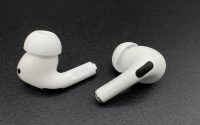Apple secrets: iPhone, Leopard, and market strategy
 Rob Mead at Tech.co.uk shared some of the “secrets” that were revealed at the Apple shareholder’s meeting at Cupertino, California.
Rob Mead at Tech.co.uk shared some of the “secrets” that were revealed at the Apple shareholder’s meeting at Cupertino, California.
Third-party apps for iPhone. First, it seems that the iPhone will be open to third-party applications. Apple CEO Steve Jobs had said that the Apple iPhone wouldn’t be open to third-party applications, that it would be a closed system based on Mac OS X (the goal was to make sure that the iPhone wouldn’t be buggy). But it now seems that Mac developers are free to make apps for the iPhone.
Leopard delay. Steve Jobs also said that the delay of the launch of the Mac OS X Leopard operating system, the next version of Mac OS X, was partly due to the iPhone. According to Jobs, the issue isn’t money; the issue is talent. It seems that Apple has dedicated a lot of time and talent to the iPhone, and there just wasn’t enough left over for the Leopard. “I wish developing great products was as easy as writing a check,” said Jobs. “If so, then Microsoft would have great products.”
The smaller and innovative iPhone. It looks like there’s a smaller iPhone on the way. Apple has made an application to the US Patent & Trademark Office for a sleek little device with a display on each side (patent number 0070103454). This “Back-Side Interface for Handheld Devices” has a rather interesting concept:
An electronic device uses separate surfaces for input and output. One of the surfaces (e.g. the bottom) includes a force-sensitive touch-surface through which a user provides input (e.g. cursor manipulation and control element selection). On a second surface (e.g. the top), a display element is used to present information appropriate to the device’s function (e.g. video information), one or more control elements and a cursor. The cursor is controlled through manipulation of the back-side touch-surface. The cursor identifies where on the back-side touch-surface the user’s finger has made contact.
In other words, the new iPhone is a dual-screen set-up with a touch screen. Hm. That reminds us of the Nintendo DS (over 40 million units sold worldwide).
Apple and the mobile phone market. Jobs also said that Apple really has to look deeper into the mobile phone market. In 2006, there were 135 million MP3 players and 200 million PCs sold. But in that same year, there were 1 billion mobile phones sold. That’s a big market to explore.
If Apple thinks that the mobile phone market is worth exploring, then we at QJ.NET wish Apple the best. Several of us love our iPods, and if Apple’s iPhone can do for mobile phones what the iPod did for “mobile audio and video,” then we don’t mind the Leopard delay at all.
Via Tech.co.uk
 Rob Mead at Tech.co.uk shared some of the “secrets” that were revealed at the Apple shareholder’s meeting at Cupertino, California.
Rob Mead at Tech.co.uk shared some of the “secrets” that were revealed at the Apple shareholder’s meeting at Cupertino, California.
Third-party apps for iPhone. First, it seems that the iPhone will be open to third-party applications. Apple CEO Steve Jobs had said that the Apple iPhone wouldn’t be open to third-party applications, that it would be a closed system based on Mac OS X (the goal was to make sure that the iPhone wouldn’t be buggy). But it now seems that Mac developers are free to make apps for the iPhone.
Leopard delay. Steve Jobs also said that the delay of the launch of the Mac OS X Leopard operating system, the next version of Mac OS X, was partly due to the iPhone. According to Jobs, the issue isn’t money; the issue is talent. It seems that Apple has dedicated a lot of time and talent to the iPhone, and there just wasn’t enough left over for the Leopard. “I wish developing great products was as easy as writing a check,” said Jobs. “If so, then Microsoft would have great products.”
The smaller and innovative iPhone. It looks like there’s a smaller iPhone on the way. Apple has made an application to the US Patent & Trademark Office for a sleek little device with a display on each side (patent number 0070103454). This “Back-Side Interface for Handheld Devices” has a rather interesting concept:
An electronic device uses separate surfaces for input and output. One of the surfaces (e.g. the bottom) includes a force-sensitive touch-surface through which a user provides input (e.g. cursor manipulation and control element selection). On a second surface (e.g. the top), a display element is used to present information appropriate to the device’s function (e.g. video information), one or more control elements and a cursor. The cursor is controlled through manipulation of the back-side touch-surface. The cursor identifies where on the back-side touch-surface the user’s finger has made contact.
In other words, the new iPhone is a dual-screen set-up with a touch screen. Hm. That reminds us of the Nintendo DS (over 40 million units sold worldwide).
Apple and the mobile phone market. Jobs also said that Apple really has to look deeper into the mobile phone market. In 2006, there were 135 million MP3 players and 200 million PCs sold. But in that same year, there were 1 billion mobile phones sold. That’s a big market to explore.
If Apple thinks that the mobile phone market is worth exploring, then we at QJ.NET wish Apple the best. Several of us love our iPods, and if Apple’s iPhone can do for mobile phones what the iPod did for “mobile audio and video,” then we don’t mind the Leopard delay at all.
Via Tech.co.uk



